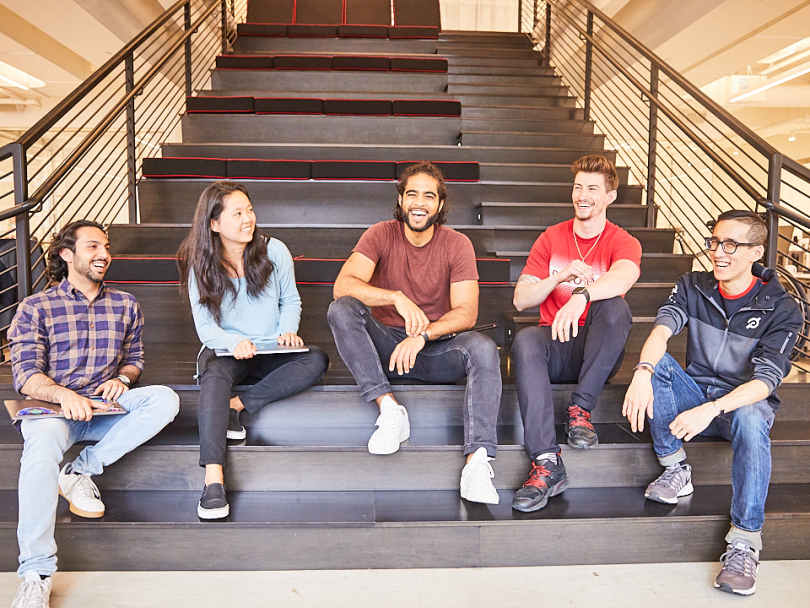Measuring around four feet by two feet, a matte-black Peloton sure looks like an exercise bike.
But for Stephanie Kaplan, it symbolizes much more.
“Peloton would not be successful if it was just a bike,” Kaplan, a senior product manager of hardware at the company, said. “There are tons of companies that have tried to place bikes in a home — that’s not new. What Peloton did is create an incredible combination of software, hardware, content and community. It lit a fire.”
Peloton’s latest launch, the Bike+, is aiming to add more kindling to that fire. Spurred on by the pandemic, sales of Peloton products have increased — the company reported its revenue grew by 172 percent in its fourth quarter ending June 30 — as people seek new ways to achieve their fitness goals without leaving their homes.
What Peloton did is create an incredible combination of software, hardware, content and community. It lit a fire.”
With a passionate fanbase, expectations ran high for Peloton’s much-anticipated new drop. As a product leader on the hardware team working on the new bike, Kaplan felt those expectations acutely.
“It’s nerve-wracking, but I think what makes it easier is that we root ourselves in the true basics of creating great products that stem from member feedback,” Kaplan said. “If you’re always putting the member first, you can’t go wrong.”
Kaplan sat down with Built In NYC to share more about what it looks like to design a new Peloton bike, how the team approaches and implements feedback and why a bike isn’t just a bike.

How did you decide which features to introduce for Bike+?
As a product manager, you want to implement the features people are asking for, but you also think about the things people didn’t think to ask for.
Auto-follow — when instructors call out resistances, the bike will adjust automatically — originally manifested as something else: On our treadmill, you can tap to increase speed. We had this idea that you could also tap to change the bike’s resistance. Then, through months of field testing, we started hearing little snippets of feedback that planted the seed for what became auto-follow.
Everything that we do, including the progression of Peloton as a bike-first company into a fitness company, has happened by watching the habits of our members change — and paying attention to that. We took what made the original Peloton bike so amazing and amplified the evolving needs of members as they’ve grown into the platform.
What’s new with Bike+
- A 24-inch touchscreen that rotates to accommodate multiple types of workouts.
- A four-speaker soundbar for increased audio quality.
- An auto-follow feature that automatically adjusts when instructors call out changes in resistance.
- Members can sync their workouts to their Apple Watches by tapping their watch to the touchscreen.
Peloton puts its users front and center. What does that mean for you as a product manager?
When you’re in your own silo, you have your blinders on. You may think something is innovative and cool, but if you’re not looking at what people want, will it really have an impact? You could just end up with something that has a bunch of features that people don’t want and might increase the cost. It’s a matter of saying, “What do you want?” instead of “I’ll tell you what you want.”
We have to look at what our members are asking and then dig deeper. It’s easy to say, “I want a rotating screen.” But that wasn't what we heard. We heard that we needed to enable an incredible experience, but maybe our members don’t know how to ask for a rotating screen or mirror casting. It’s our job to interpret and transform feedback into a product feature. To me, that’s how you go after something less from a product-feature perspective and more of a customer-focused mindset.

Aside from users, you have a bit of a secret weapon in gathering feedback.
We talk to our instructors a lot because they ride our bikes for hours and hours each week. We often ask them, “Hey, we’re thinking of designing these features. What do you think about it? Have you wanted to coach that?”
We try to have an open line of communication. Take our bike boot camp: We talked to the instructors in advance and then built certain features into the bike and the software that allows for that particular experience.
Another thing that’s so great about our instructors is that they’re often a conduit for so much member feedback. By going to them and asking what they’re hearing and seeing allows us to have a deeper view of what’s going on.
More than a high-five
The bar is pretty high for Peloton products. How do you ensure you meet user expectations?
It’s nerve-wracking, but I think what makes it easier is that we root ourselves in the true basics of creating great products that stem from member feedback. If you’re always putting the member first, you can’t go wrong.
Everyone on our team has this obsessive trait of being passionate about the product.”
We have a Slack channel dedicated to what people have heard. I’m a member of probably 30 different Facebook Peloton groups so I can hear from different people and take stock of that feedback. I think that’s how you meet expectations — by really being open and taking the time to listen. I’d rather our members be incredibly passionate about what we’re doing and have strong opinions because that means we’re doing something right.
The most time-consuming thing is to just stop and listen. But everyone on our team has this obsessive trait of being passionate about the product and about the mission to change people’s lives through fitness. It’s become a part of my own DNA that I can’t shut off.
Talk to us about what kind of cross-collaboration was needed to launch Bike+.
The ability to collaborate and get feedback across teams is really important, and we start that really early in the process. We talk to the content team early so that things don’t come up and surprise us. We spend time talking to our field quality engineers and our field ops teams: I spend a lot of time going to the warehouse and hanging out with the team members who are building the bikes and delivering them.
There’s this idea that we should constantly be collaborating and listening across functions to learn because everything we do integrates with every other team. We can’t do anything without input and teamwork from other functions. I am just one small piece of a very large team that brings this to life.
SPECIAL DELIVERY
What’s the response to the Bike+ been? Have there been any adjustments since launching?
Because the Bike+ was based on member feedback, a lot of people felt like we had listened to them. People are enjoying it in a way I had dreamed that they would.
We really haven’t had any software changes thus far. We were doing field testing up until the day of launch. Sometimes, we’d catch a little bug and I’d watch a swarm of people way smarter than me pounce on it. They’d figure it out in 30 minutes, send a patch and boom, it was fixed.
It’s exceptionally hard to make wrong decisions if you keep the member experience at the forefront of your mind, and don’t allow yourself to get distracted by shiny things. Do the things that matter. Make a difference in the areas that matter.






